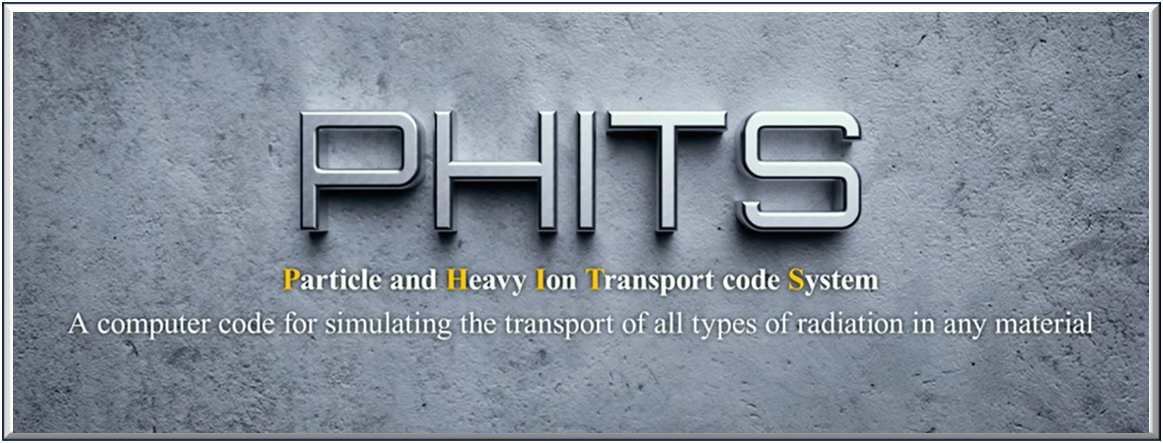
What is new?
2024/08/27: Open the website of PHITS workshop + Intermediate course at JAEA (detail)
2024/07/26: Announcement of Advanced PHITS Tutorial at USM, Malaysia (detail)
2024/07/22: Announcement of Advanced PHITS Tutorial at FRIB USA (detail)
2024/04/25: Announcement of PHITS intermediate course and mini-workshop in South Korea (detail)
2024/04/19: Release of PHITS3.34 (detail)
2024/04/19: JENDL-5 optimized for PHITS is available from library page
2024/04/17: Contact page is fixed except for the access from JAEA
2024/03/07: Contact page is temporarily out of service. Please send inquiries to phits-en-officejaea.go.jp.
2024/02/08: Announcement of PHITS in-person tutorial in OECD-NEA, Paris, France (detail)
2024/01/26: Announcement of PHITS in-person tutorial in Dalat, Vietnam (detail)
2024/01/26: Announcement of PHITS in-person tutorial in Purwokerto, Indonesia (detail)
2024/01/10: Announcement of PHITS in-person tutorial in Madrid, Spain (detail)
2024/01/10: Announcement of Online tutorials in 2024 (detail)
2023/11/12: Official reference for PHITS is updated (see below)
2023/10/18: PHITS becomes available through OECD/NEA GitLab (detail)
2023/08/03: Announcement of PHITS in-person tutorials in China (detail)
2023/08/03: Announcement of PHITS in-person tutorials in Argentine (detail)
2023/04/26: Announcement of PHITS in-person tutorials in Cameroon (detail)
2023/04/19: Release of PHITS3.31 (detail)
2023/02/20: Announcement of Online tutorials in 2023 (detail)
2023/02/06: Announcement of PHITS in-person tutorials in Asian countries (detail)
What is PHITS?
PHITS (Particle and Heavy Ion Transport code System) is a general purpose Monte Carlo particle transport simulation code developed under collaboration between JAEA, RIST, KEK and several other institutes. It can deal with the transport of all particles over wide energy ranges, using several nuclear reaction models and nuclear data libraries. PHITS can support your researches in the fields of accelerator technology, radiotherapy, space radiation, and in many other fields which are related to particle and heavy ion transport phenomena. (detail, pdf 5.3MB)If you have not registered yet, please visit how to get page.
User support
PHITS Youtube Channel PHITS Facebook PHITS Forum



How to refer PHITS?
Please explicitly write the version of PHITS you used, and refer the following document in context of using any version of PHITS (updated on 2023/11/12).
T. Sato, Y. Iwamoto, S. Hashimoto, T. Ogawa, T. Furuta, S. Abe, T. Kai, Y. Matsuya, N. Matsuda, Y. Hirata, T. Sekikawa, L. Yao, P.E. Tsai, H.N. Ratliff, H. Iwase, Y. Sakaki, K. Sugihara, N. Shigyo, L. Sihver and K. Niita, Recent improvements of the Particle and Heavy Ion Transport code System - PHITS version 3.33, J. Nucl. Sci. Technol. 61, 127-135 (2024)
This is an open access article, and you can download it from here.
Please also refer the following about benchmark calculations, when you discuss about the accuracy of PHITS.
Y. Iwamoto, S. Hashimoto, T. Sato, N. Matsuda, S. Kunieda, Y. Çelik, N. Furutachi and K. Niita, Benchmark study of particle and heavy-ion transport code system using shielding integral benchmark archive and database for accelerator-shielding experiments, J. Nucl. Sci. Technol. 59, 665-675 (2022).
Open access
Manual and Update
You can download the latest version of PHITS manual in pdf here.
Update log of PHITS manual is here.
Update log of PHITS is here.
Request PHITS tutorial
You can request to organize PHITS tutorial courses outside Japan subject to following conditions
1, All participants must submit the license agreement form of PHITS prior to the tutorial
2, All participants should not belong to institutes related to weapon research
3, Organizer (or participants) cover the traveling expense and accomodation cost of the lecturer (normally one person)
To request for PHITS tutorial, please contact PHITS office.
We are waiting for your request!
Logo & Mascot
You can freely use the logo of PHITS in any materials (reports, presentations, products) to which PHITS contributed, but modification is not allowed. This logo is inspired from the animation of the maze-structure shielding simulation shown in the PHITS introduction slide.
Download: Type A (png, jpg), Type B (png, jpg), Type C (png, jpg), Type D (png, jpg)
You can also use the mascot of PHITS named Phi-chan. He is a owl having the character of Φ (phi) in his face. Owl is a symbol of wisdom in Japan.
Download: smile (png, jpg), crying (png, jpg), thinking (png, jpg), sleeping (png, jpg), happy1 (png, jpg), happy2 (png, jpg)
Development members
Tatsuhiko Sato, Yosuke Iwamoto, Shintaro Hashimoto, Tatsuhiko Ogawa, Takuya Furuta, Shinichiro Abe, Takeshi Kai, Norihiro Matsuda, Yuho Hirata, Takuya Sekikawa, Lan Yao, Pi-En Tsai*, Hunter N. Ratliff**: JAEA,Japan
Yusuke Matsuya: Hokkaido University, Japan
Hiroshi Iwase, Yasuhito Sakaki, Kenta Sugihara: KEK, Japan
Nobuhiro Shigyo : Kyushu University, Japan
Lembit Sihver : Technische Universitat Wien, Austria
Koji Niita : RIST, Japan
*Current affiliation: Zap Energy, USA
**Current affiliation: Western Norway University of Applied Sciences, Norway
The following members also contributed to the development of PHITS
Hiroshi Nakashima, Tokio Fukahori, Keisuke Okumura, Tetsuya Kai, Shusaku Noda, Yukio Sakamoto, Hiroshi Takada, Shin-ichiro Meigo, Makoto Teshigawara, Fujio Maekawa, Masahide Harada, Yujiro Ikeda : JAEA, Japan
Satoshi Chiba : TITech, Japan
Takashi Nakamura : Tohoku Univ., Japan
Davide Mancusi : Chalmers Univ. of Tech., Sweden
PHITS-user distribution map since FY2019 (last update: 2023/04/19)
/ All users


